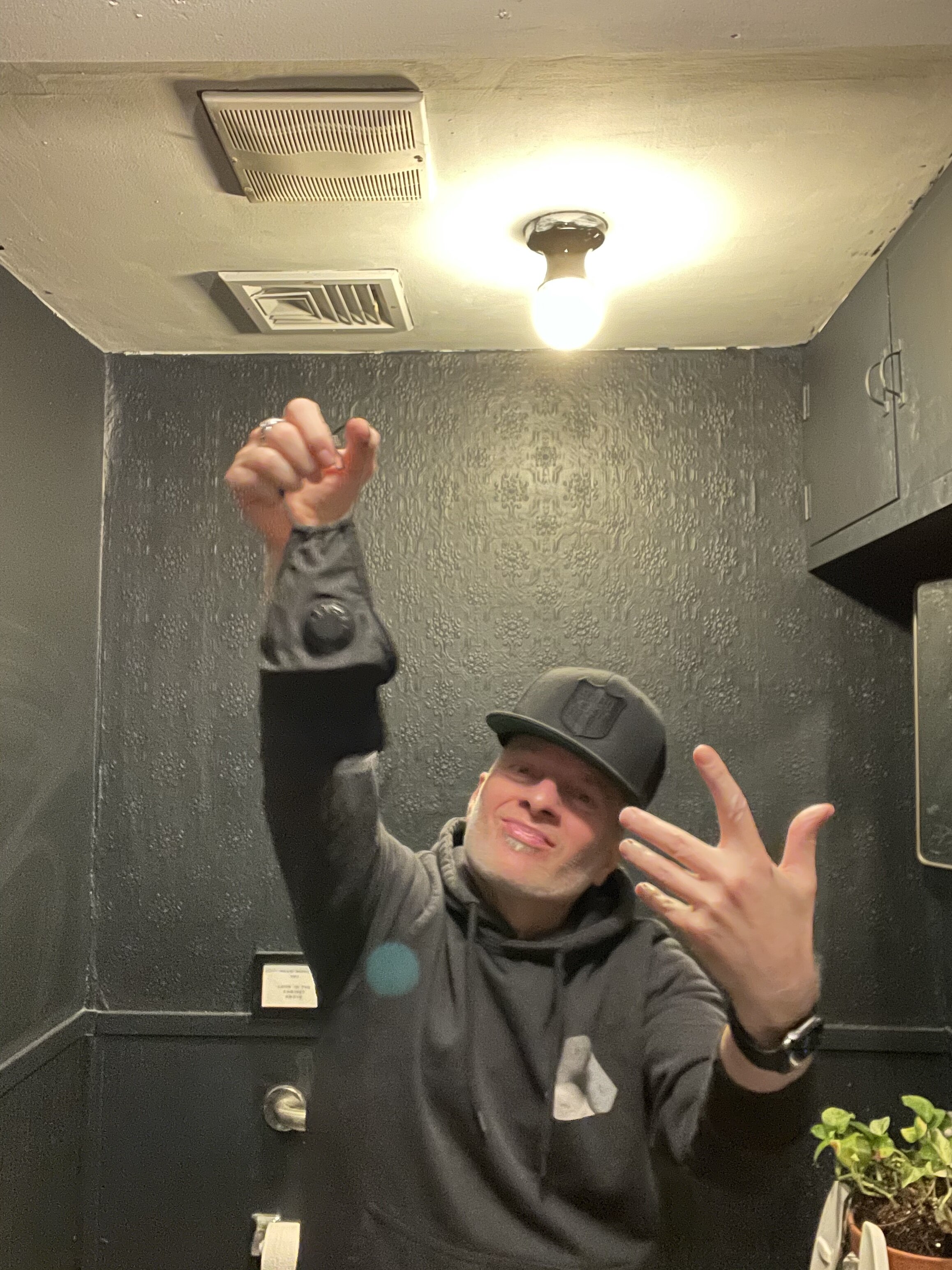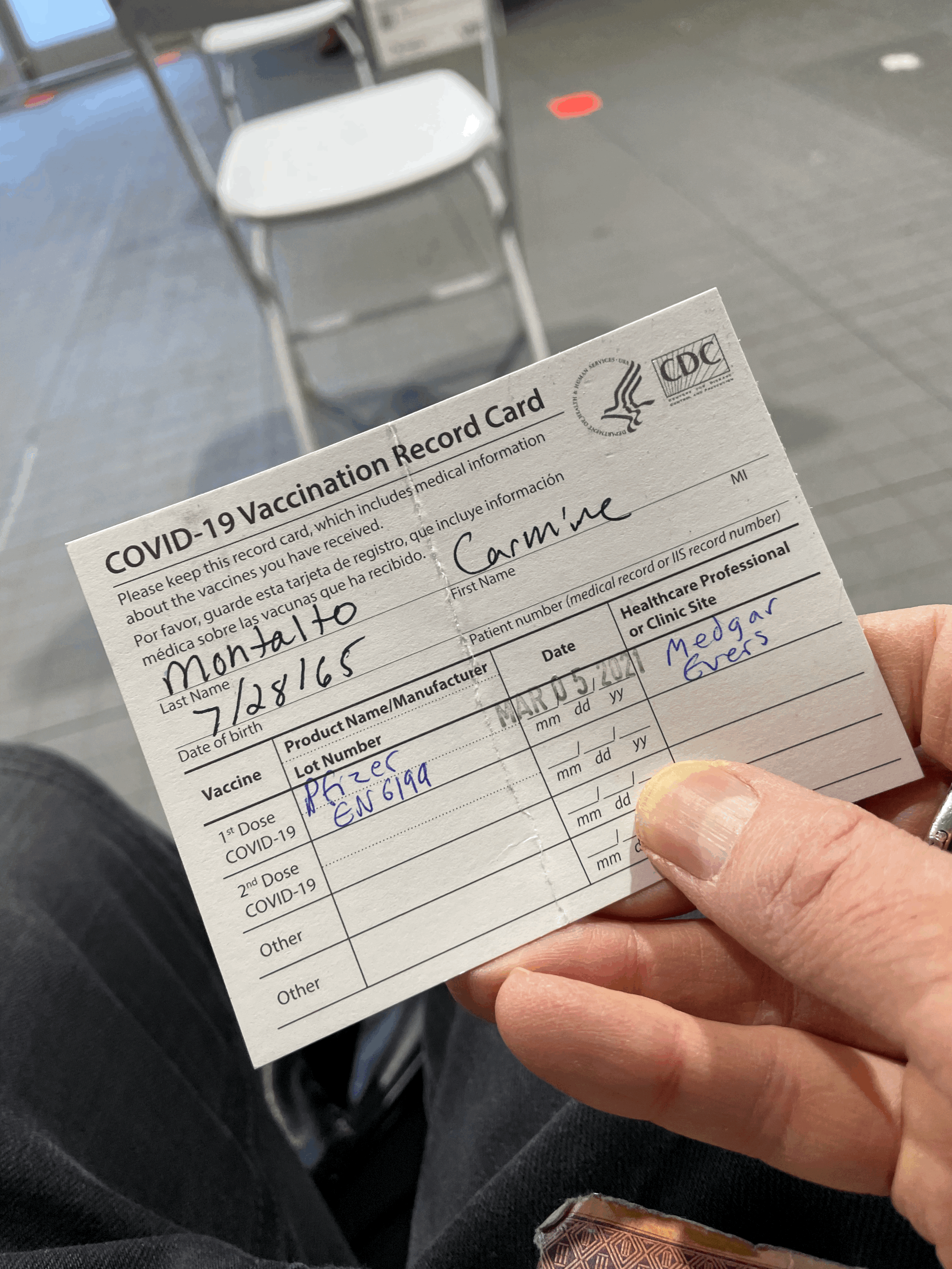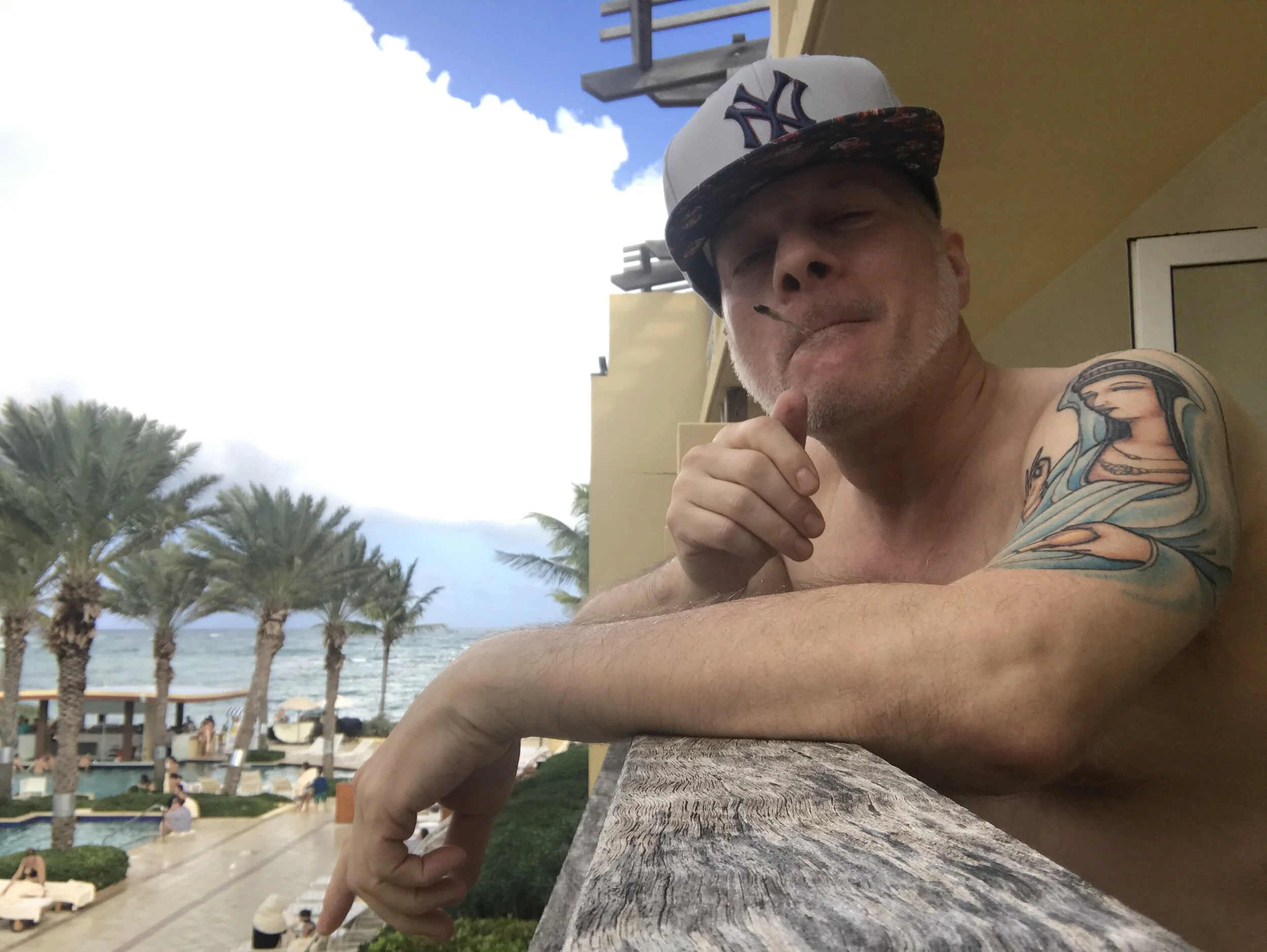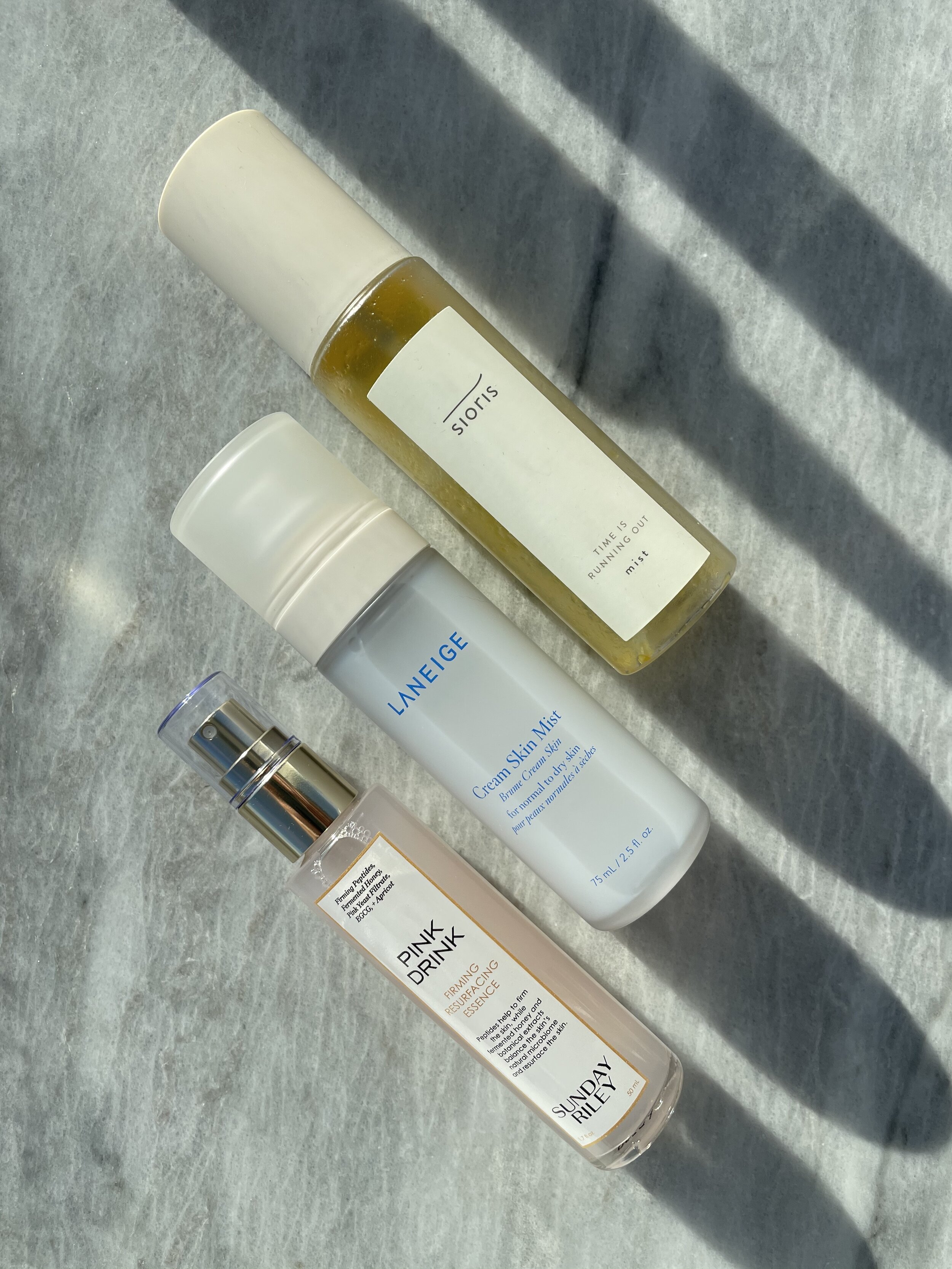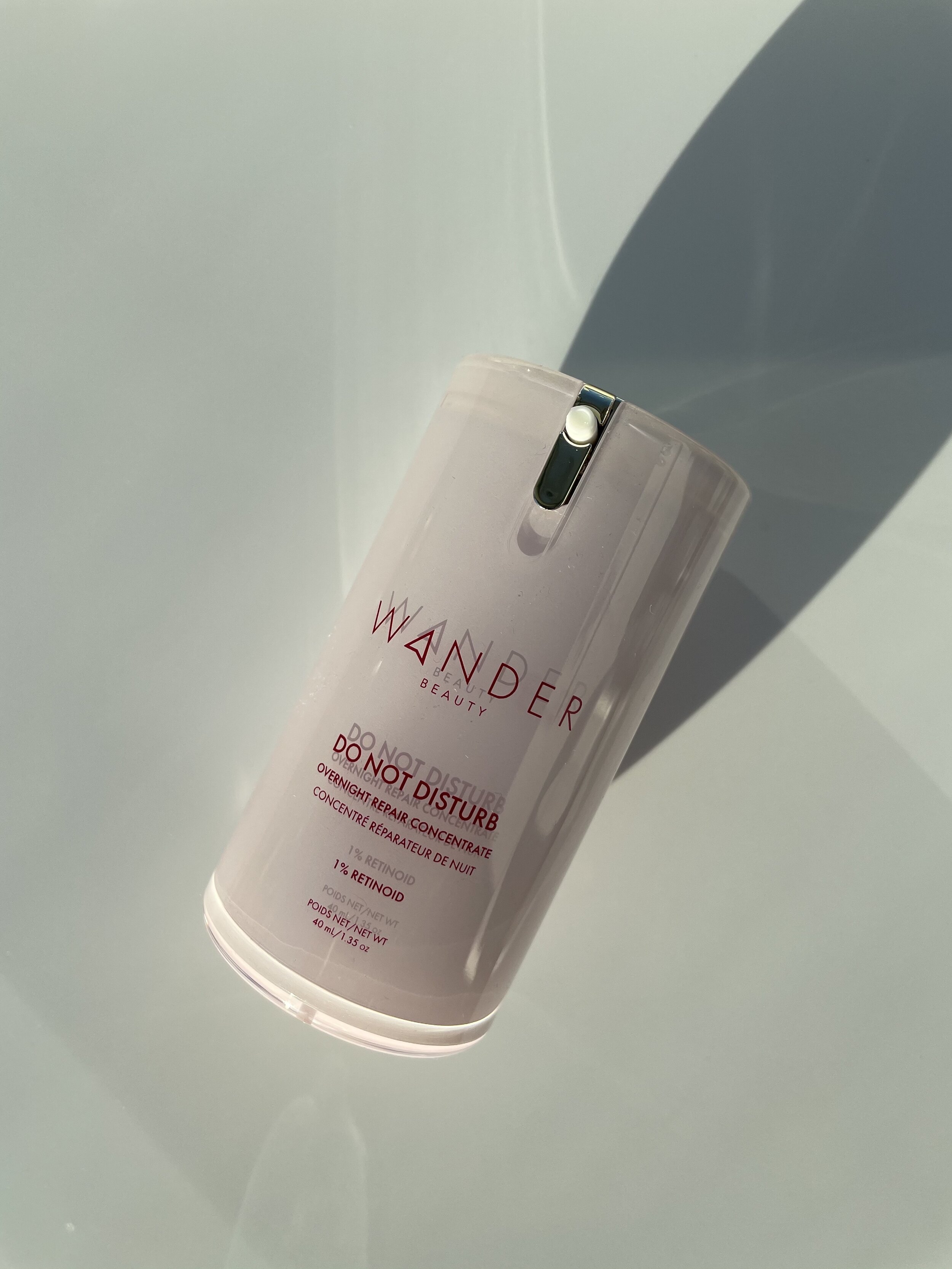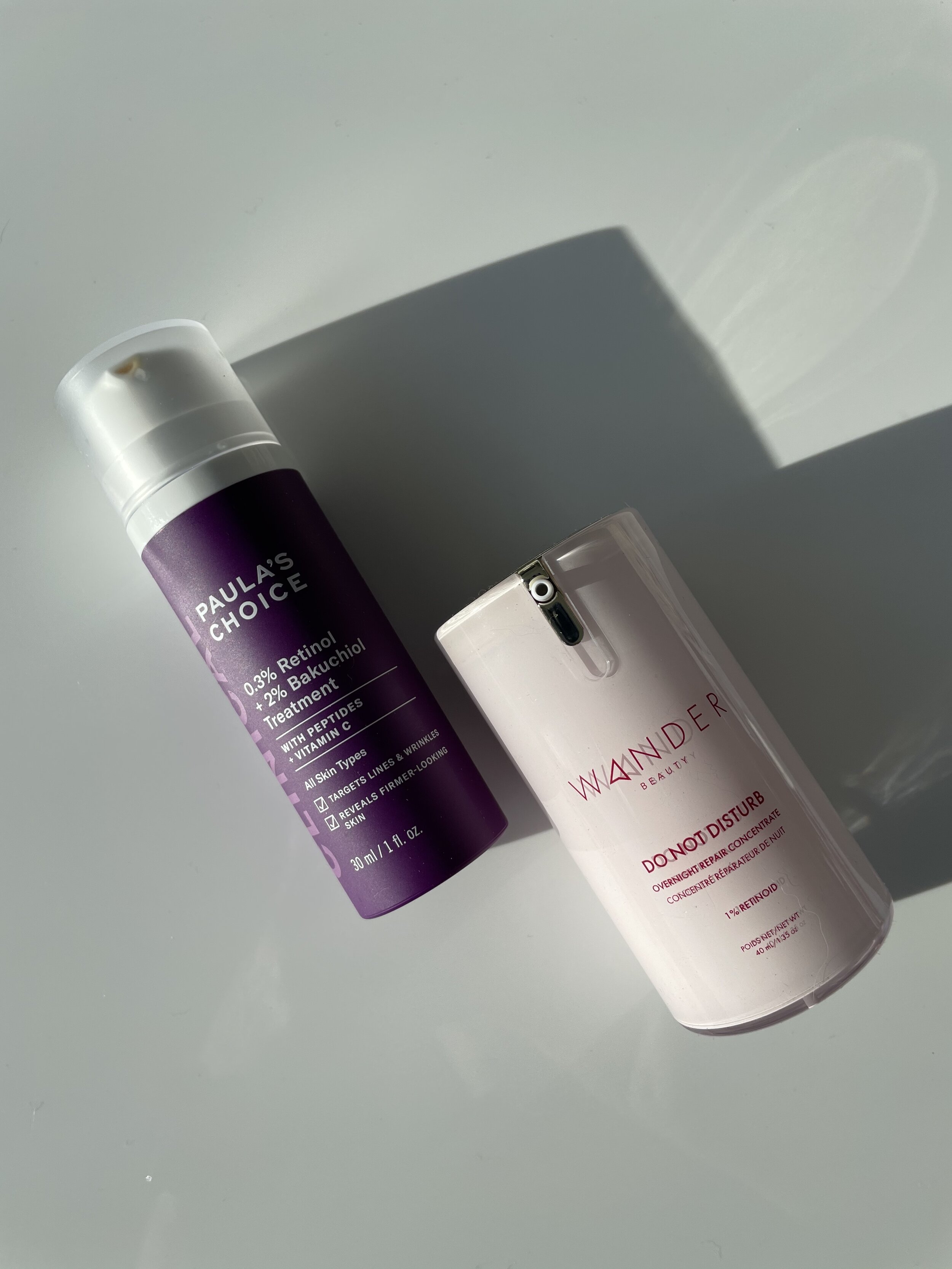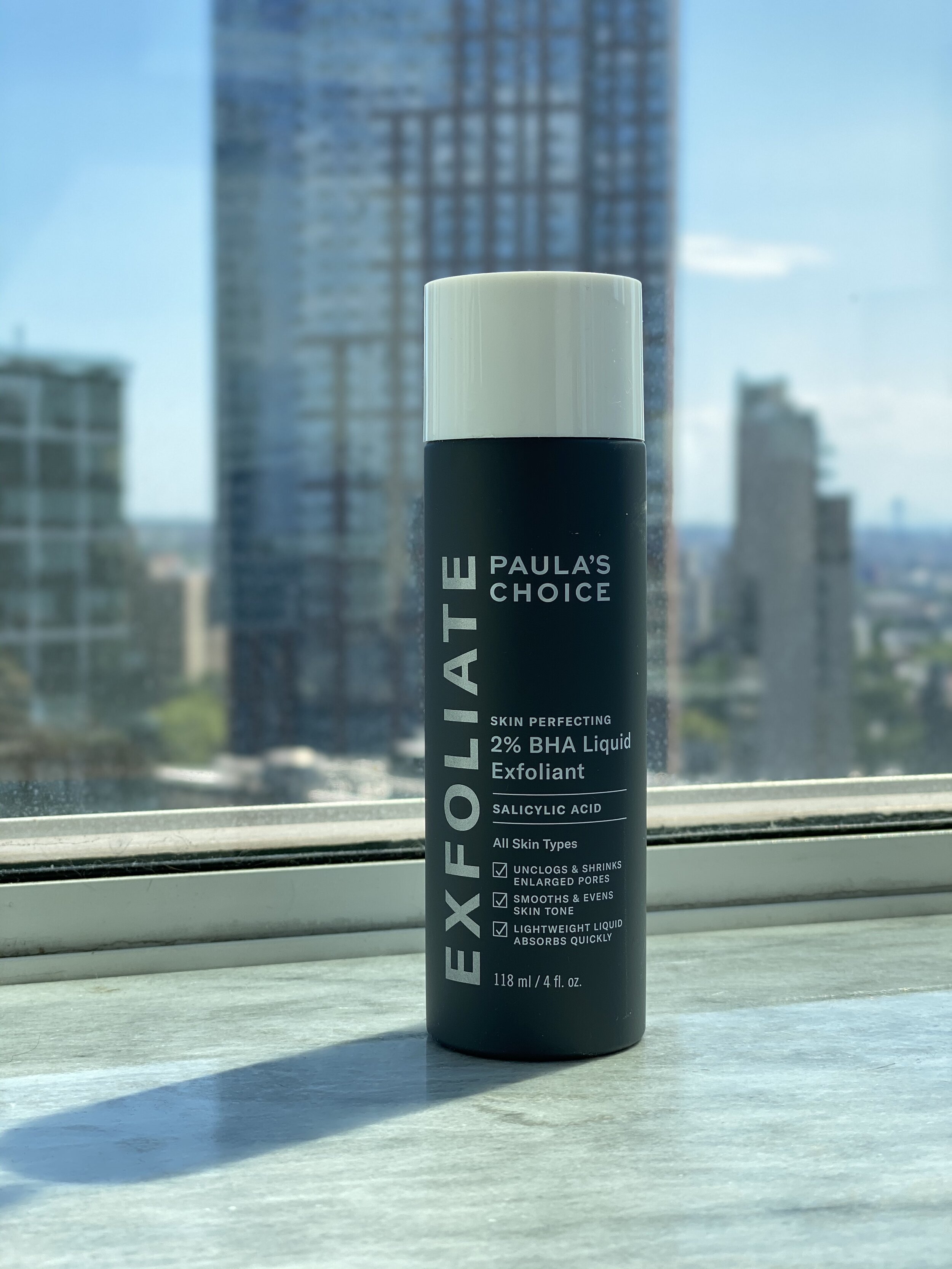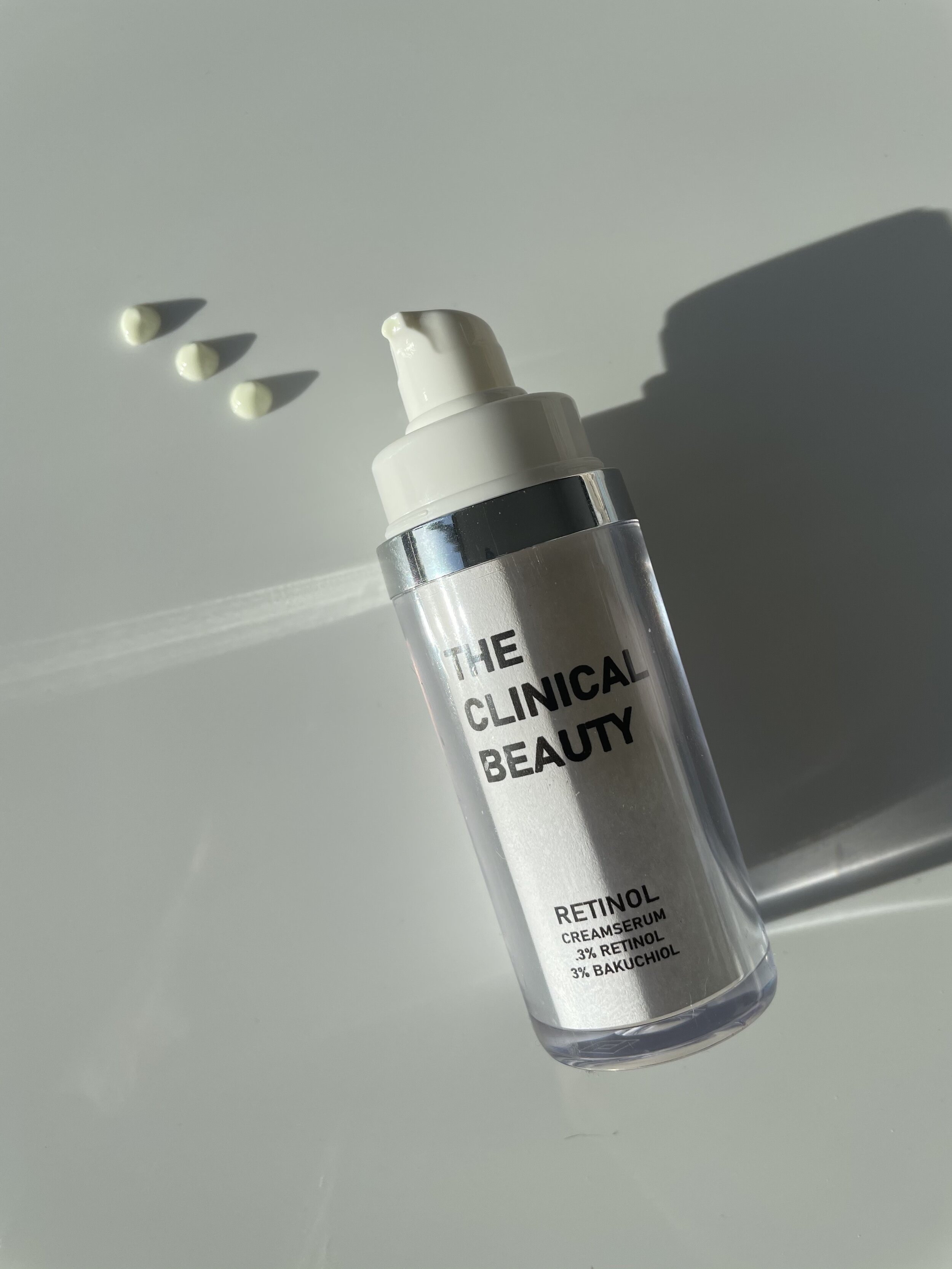RETINOL, RETINOIDS, RETINOIC ACID PART ONE: BEST RETINOL SERUMS, BEST RETINOL CREAMS FROM PAULA'S CHOICE, WANDER BEAUTY AND FIRST AID BEAUTY
As I write this, I’m feeling a slight twinge in my left upper arm. It’s not pain, exactly. It’s more like an intense sensation. Like I ran into something, a door knob or side of a building.
Hey, I’m in New York, I run into sides of buildings all the time. I once tore the pants of my suit on my way to work by scraping up against the side of a building. New York is a weirdly cramped place.
No, this was far more eventful than all of that. I got the first of two shots of the Pfizer Covid vaccine yesterday afternoon. I’m breathing a sigh of relief this morning — make that exhaling after a year of holding my breath. It feels like the end is coming. A good ending.
And, as eventful as it seemed this day would be, actually getting the shot wasn’t much of a big deal. I thought I’d be waiting in a two-hour line running the length of Brooklyn. But, from beginning to end, I was barely there an hour.
The wait to enter the complex, essentially a field army hospital set up inside a Covid-shuttered high school in Crown Heights, was maybe 10 minutes. They checked me in and directed me to go down a long hallway to wait in a short line with perhaps 10 other Brooklynites. We were queued up to enter what appeared to be the high school gym — with enclosed, makeshift medical stations lining the walls.
After a quick, five-minute consultation with an army medic, he shot me in the left arm (right in the middle of Guanyin’s forehead!) and I was done. They advised chilling on one of the folding chairs in the center of the gym for 15 minutes just to be safe. Once my 15 minutes was up, I bolted and headed home.
On the subway ride home, it felt like I had passed into another world.
I know it’s not over for me — I have to get the second shot in three weeks. And, of course, it’s not over for any of us. Until it is, we’re all still in it. But this feels like a milestone, like the long horrible year will be in the rearview mirror soon.
The past twelve months have certainly been transformational. Everything about my life, everyone’s lives, has been upturned. I miss people. I miss seeing my friends. I miss having dinners out, exploring the world around me — and the world beyond. Those spontaneous, long weekends spent in Tokyo feel like a different person’s life.
I don’t know that guy any more. Would I literally get on a plane and land in Tokyo 14 hours later? Just to hang out? Those experiences were everything. One of those long weekends was when I got my Guanyin tattoo — the very same one that served as the injection site of the Covid vaccine.
This annus horribilis is coming to a close…
The skincare stuff starts here.
Those long 14-hour flights to Tokyo were magical. I know lots of people hate to fly, but I lived for those flights. I always splurged on a first- or business-class ticket. I would kick back, settle in, and shut down. I sure had my Tokyo flight rituals. On every flight to Japan, I would watch Lost in Translation, starring Bill Murray and Scarlett Johansson. And, of course, I always selected the Japanese cuisine options. Breakfast was the most bizarre assortment of things I never understood.
I had my skincare routines, too. In-flight skincare was near constant. It started with my PM routine to remove the sunscreen and settle in for the flight. Then, a sheet mask! I remember the days when sheet-masking on a flight was seriously weird. I did it anyway. Throughout the flight, I would rehydrate with a face mist and humectant serum.
FAVORITE FACE MISTS FOR KEEPING SKIN HYDRATED – BEST HYDRATING TONERS FOR DEHYDRATED SKIN
Trans-epidermal water loss (TEWL) is never a good thing — at any altitude. And once your skin dehydrates, it’s nearly impossible to maintain your skin health and arrive at your destination looking anything but half-dead. So I would do everything I could to defend my skin’s hydration levels on those long flights to Tokyo.
I’ve only recently discovered the brand Wander Beauty. Wander is all about skin care on the go — as you wander through your day, and across the world. I wish I’d had those iconic gold-flecked Baggage Claim Eye Masks with me back then. And the brand’s Do Not Disturb Overnight Repair Concentrate is one of the best retinol serums for face I’ve come across.
I haven’t always been a fan of Retinol and Do Not Disturb has literally transformed how I feel about Retinol treatments. (More on the Wander Beauty Do Not Disturb Overnight Repair Concentrate below.)
My first real experience with Retinol was the Paula’s Choice Clinical 1% Retinol Treatment. To me, that’s the OG of Retinol products. Much like the Paula’s Choice 10% Niacinamide Booster is the OG Niacinamide serum — and perhaps the best anti-aging serum ever. (Psst…I’ve reviewed it on the blog here.)
PRODUCT REVIEW: PAULA’S CHOICE 10% NIACINAMIDE BOOSTER – THE BEST NIACINAMIDE SERUM
Paula’s 1% Retinol Treatment made Retinol an indispensable part of my regular skincare routine. My first experience with it was like playing with fire. Retinol is like that. You have to proceed with caution. Many people build up a tolerance for it that allows them to use it daily.
Not me. I can use a Retinol treatment once, sometimes twice, a week. You have to find your own balance. It took me a long time to accept that I wasn’t going to get up to daily use — and didn’t need to.
What Is Retinol and What Does Retinol Do for the Skin?
It’s commonly accepted that Retinol and retinoids, more specifically, are the gold standard in anti-aging. Like Vitamin C and Niacinamide (Vitamin B3), the Vitamin A derivative has multiple pro-skin health, anti-aging benefits. Among them are the smoothing of lines and wrinkles, potent antioxidant defense and visible skin firming. As with Niacinamide, topical retinoids — as all derivatives of Vitamin A are referred to — can even minimize the appearance of pores and defend skin against aging environmental damage.
There’s a superb piece on retinoids by the experts on the Paula’s Choice Research Team titled, The Complete Guide To Retinol: The Anti-Aging (And Anti-Acne) Hero — which you can catch here. Here is what I found most salient:
Retinol is classified as a Cell-Communicating Ingredient, which means that it can tell a skin cell how to behave. Retinol ‘tells’ developing skin cell in the lower layers of the skin – called the dermis, to develop normally, instead of a sun-damaged or genetically malformed skin cell. This is how, over time, Retinol can address multiple skin concerns.
Another way Retinol works is also by telling the older cells in the upper layer of skin to die quicker which in turn allows the newer, healthier skin to surface faster. This quicker skin cell turnover rate, paired with cell communicating abilities is what makes Retinol such a superstar!
There are many derivatives and strengths of retinoids available in both over-the-counter (OTC) and prescription products today. The term “Retinol” is the name of the purest form of Vitamin A, and used most often to refer to the non-prescription version of Retinoids.
However, Retinol itself is not active. It has to go through a conversion process in the skin to get to the active form which is then usable by the skin.
Retinyl Palmitate –> Retinol — > Retinaldehyde –> All-Trans-Retinoic Acid (Tretinoin)
There are many forms of retinoids used in skincare today and it can get confusing. Brands and their formulators have multiple format options in seemingly infinite concentrations, depending on the formulation and the product’s claims positioning. Here is a breakdown of the most common forms with a brief description.
Retinyl Palmitate
This form of Vitamin A is created by combining Retinol, or pure Vitamin A, and palmitic acid – a saturated fatty acid derived from palm oil. Retinyl Palmitate is actually naturally occurring in the skin. Because of the lengthy conversion process required within the skin, it’s the least effective of the retinoids. As the weakest form, it’s also generally the most well tolerated.
Retinyl Palmitate gets a bad rap and is on the clean beauty ingredient hit lists of both Sephora and Credo, meaning a formula that contains it cannot be classified as “clean”. According to the experts on the Paula’s Choice Research Team, the claims that it’s unsafe are “based on a study from nearly 20 years ago that has never been reproduced or tested under real-life conditions such as how people use sunscreens that contain this ingredient.”
Retinol
The term “retinol” has become the catch-all for all forms of retinoids in skincare marketing. To be exact, Retinol is the name for the entire vitamin A molecule and the purest form of the antioxidant vitamin. While its anti-aging benefits are proven, it also has legitimate downsides; notably, Retinol can cause extreme sensitization, irritation, redness, dryness and unsightly flaking of the skin.
What causes Retinol irritation? Well, in order to achieve the unparalleled results of Retinol, the molecule must go through a lengthy molecular transformation in the skin as it converts to retinoic acid. It is this conversion process that causes the significant downsides associated with Retinol.
Ironically, while it’s known for causing skin sensitivity, Retinol is also quite sensitive itself. It needs to be packaged in an opaque, air-tight pump as it easily degrades in the presence of light and air. Just like its BFF Vitamin C!
Retinaldehyde (Retinal)
Retinal is even more potent and effective on the retinoid scale than Retinol itself. Interestingly, “Retinaldehyde has promise in being an anti-acne treatment, without the same harsh side effects of its prescription cousins.”
Because it is perhaps the most expensive of the retinoid class, it’s seldom used in topical skincare products — and is reserved for the savvy marketers who want their Retinol treatment to sound unique and to boast the highest efficacy without a prescription. The default is most often to formulate with the less expensive Retinol. Because of its higher potency, Retinaldehyde is used in lower concentrations, which can give the impression that the formula is weaker from a marketing perspective.
Retinyl Retinoate
This synthetic form of Vitamin A is part of a new generation of retinoids. Because of its slower conversion in the skin into Retinoic Acid, studies have shown it to be less problematic for skin than Retinol and pure form of topical Retinoic Acid — more commonly known as Tretinoin or Retin-A.
Because of the serious downsides of using Retinol, Retinyl Retinoate may become increasingly popular in the years ahead.
Hydroxypinacolone Retinoate (HPR) or Granactive Retinoid
Marketed as Granactive Retinoid, Hydroxypinacolone Retinoate (HPR) is the newest and most promising member of the class of anti-aging retinoids. HPR is an ester of retinoic acid with benefits on par with prescription-strength retinoic acid, commonly known as Tretinoin or Retin-A. The greatest benefit is that HPR is more readily tolerated by the skin, with none of the side effects of Retinol or retinoic acid — including irritation, sensitivity, dryness and flakiness.
How is it possible to have the upside without the downside? In order for the skin to benefit from Retinol, the Vitamin A molecule goes through a transformation process as it converts to retinoic acid in the skin. It is this conversion that leads to the irritation common to Retinol. Hydroxypinacolone retinoate does not require a lengthy conversion in order to achieve the sought-after anti-aging benefits of Retinol, making it far more tolerable.
Tretinoin / Retin-A
With Retinyl Palmitate at the low end of the retinoid scale, Tretinoin (or Retin-A) is at the exact opposite end — the strongest of the retinoids known as retinoic acid, the generic name for synthetic Vitamin A. Tretinoin is only available by prescription in most countries — except notably, Mexico, where its access is quite pervasive. Even I have been caught up in grabbing tubes of Retin-A at the airport before my flights home.
While Tretinoin is commonly used to treat signs of aging including fine lines, wrinkles and dark spots, the versatile medication is also an effective treatment for acne and sun-damaged skin. According to the Healthline website, “It may sound counterintuitive, but tretinoin works by irritating the skin. Tretinoin is able to speed up the life cycle of skin cells. It makes them divide faster and die faster, so newer, healthier cells can take their place.”
Let’s take a look at the first five of my favorite retinoid products in my two-part series on the best anti-aging serums, face creams and eye creams…
Wander Beauty | Do Not Disturb Overnight Repair Concentrate
The Wander Beauty Do Not Disturb Overnight Repair Concentrate is a more interesting retinol treatment than I’m used to. It’s a far sensorial experience and quite literally a pleasure to use. That’s not something I often say about Retinol products.
Can a Retinol treatment be pleasurable?
Yes it can! Wander Beauty’s Do Not Disturb is proof that it can. The closest I come to enjoying Retinol is with the Paula’s Choice CBD Oil + Retinol, a rich and velvety facial oil. (I’ll review it in part two of my series on Retinol!)
Do Not Disturb is a lightweight cream (or is it a thick lotion?!) infused with a multitude of nourishing non-fragrant plant oils, many with antioxidant potency, including Camellia Japonica Seed Oil (Tsubaki) and Camellia Sinensis Seed Oil (Green Tea). Both are rated among the best antioxidants for skin by the Paula’s Choice Research Team.
There’s also a smattering of Palmitoyl Pentapeptide-4, commonly known as Matrixyl for perhaps a bit of a plumping, wrinkle smoothing boost.
The star active is, of course, Hydroxypinacolone Retinoate, or HPR. Commonly known as Granactive Retinoid, HPR is one of the most effective OTC forms of retinoids. It’s known to have efficacy on par with Retinoic Acid, aka Tretinoin or Retin-A, but without the irritation.
How is it possible to have the upside without the downside?
As I said earlier, in order to attain the sought-after benefits of Retinol, the Vitamin A molecule goes through a conversion process to become retinoic acid in the skin.
It is this conversion that leads to the irritation — and all the downsides of Retinol. HPR does not require conversion in order to achieve the anti-aging benefits of Retinol. All upside, no downside.
I found further insights on HPR by the Paula’s Choice Research Team in an article titled, The Complete Guide To Retinol: The Anti-Aging (And Anti-Acne) Hero.
“Because HPR is an ester of Retinoic Acid – the active form of Retinol, instead of an ester of Retinol — it doesn’t have to go through the same conversion process to be used directly by skin. So, in theory, a lower amount of HPR can elicit the same results as higher concentrations of Retinol. Although it sounds very promising and is already found in a few skin care products (marketed as Granactive Retinoid), there is a lack of independent studies at the moment to further test and verify these manufacturer claims.”
Do Not Disturb does have one drawback, at least for me. It contains Lavender Oil which, while infusing the treatment with a pleasant, soothing aroma that demands quietude (“do not disturb!”), has the potential to irritate the skin.
If you’re sensitive or sensitized to fragrance and fragrant plant oils in skin care, this isn’t for you. If not, you may enjoy Do Not Disturb as much as I have been.
I’ve experienced no irritation whatsoever using the Wander Beauty Do Not Disturb Overnight Repair Concentrate and, again, really like using it — something I just don’t say about retinol treatments. I hate the smell of higher concentrations of retinol!
Do Not Disturb also doubles as a perfectly adequate moisturizer for nighttime use.
SHOP THE BLOG: Purchase the Wander Beauty Do Not Disturb Overnight Repair Concentrate for $68 here.
SHOP THE BLOG:
Paula’s Choice | 0.3% Retinol + 2% Bakuchiol Treatment
I first posted a glimpse of the Paula’s Choice 0.3% Retinol + 2% Bakuchiol Treatment on #skincarmasaturday on my IG Page a couple of weeks ago. That’s when I like to preview new product discoveries of the past week — and Paula’s innovative anti-aging treatment was something I’d had my eye on for a while. I couldn’t wait to try it!
Earlier, I reviewed the Wander Beauty Do Not Disturb concentrate with the newest retinoid, HPR — an analog of retinoic acid, or Tretinoin. As I’ve said, I’m not a big fan of straight up Retinol treatments. But as a retinoid, rather than Retinol itself, Wander’s DND has been a surprisingly pleasant experience to me. I sure wasn’t expecting to like it as much as I actually did.
Normally, I’m not fan of Retinol treatments. I hate the smell of Retinol; and I really hate the irritation. I usually just stick with Bakuchiol so I get the benefits of Retinol without all the nasty downsides.
I first reviewed the burgeoning market for Bakuchiol products nearly two years ago in an article titled, Bakuchiol Retinol Alternative Anti-Aging Serums From The Inkey List, Herbivore & More! You can still catch that piece here. The marketplace has come quite a long way since that initial Bakuchiol rundown.
And, of course, my favorite Bakuchiol serum of all time, the Herbivore Bakuchiol Retinol Alternative Serum was named the Skincarma Product of the Year for 2019! The product was so popular that it was out of stock for most of 2020. In fact, I was worried it would never come back. Alas, just as the holiday season kicked off, it returned! If you haven’t tried it yet, you can grab a bottle of Herbivore’s fantastic hydrating serum with Bakuchiol here.
BAKUCHIOL RETINOL ALTERNATIVE ANTI-AGING SERUMS FROM THE INKEY LIST, HERBIVORE & MORE!
What Is Bakuchiol?
For insights on what Bakuchiol is and how it can be considered a viable alternative to Retinol, I turn again to the experts on the Paula’s Choice Research Team:
A natural antioxidant and anti-aging ingredient found in the seeds and leaves of the plant Psoralea corylifolia. This plant, also known as babchi, is native to and grows throughout India, where it plays a role in Ayurvedic medicine, and is also found in China (where it’s used in Chinese natural medicine) as well as parts of Africa. Ongoing in vitro (Petri dish) and in vivo (on skin) research has shown that bakuchiol seems to have skin-restoring ability when applied twice daily, and that it may also have a brightening effect on skin. Research has also shown this plant ingredient has soothing and anti-wrinkle properties as well as helping to visibly improve skin color and tone.
Bakuchiol is often touted as an alternative to retinol minus the sensitizing effects some people experience from retinol. The association between bakuchiol and retinol is because many of its benefits seem to mimic what retinol does; however, it’s important to distinguish that bakuchiol is not identical to retinol. It’s not an equivalent replacement any more than a blueberry is the nutritional equivalent of an apple.
Science has revealed that bakuchiol interacts with many of the same areas in skin as retinol, sometimes by taking the same pathway, other times by going a different route but still leading to the same results, such as diminished wrinkles, improved elasticity, and smoother skin. In either case, we’re confident that bakuchiol is a promising, beneficial ingredients whose actions can complement and enhance what retinol does for skin.
Research has confirmed that bakuchiol works best in concentrations between 0.5-2%. Amounts lower than that have not been shown to provide retinol-like benefits.
Of course Paula Begoun and her namesake brand had the smarts to create a top shelf anti-aging treatment that combines Retinol with Bakuchiol. And like the Wander Beauty Do Not Disturb, the Paula’s Choice 0.3% Retinol + 2% Bakuchiol Treatment is a pleasure to use! A 0.3% concentration of Retinol is a moderate strength — and, don’t quote me, the max allowed in an OTC product in Europe.
It’s the 2% Bakuchiol that really maximizes the anti-aging potency in the 0.3% Retinol + 2% Bakuchiol Treatment.
In fact, according to the experts on the Paula’s Choice Research Team, “Research shows that bakuchiol and retinol work even better together. Plant-derived bakuchiol is one of a few ingredients that can stabilize retinol, allowing it to work more effectively and for longer, even at a lower concentration.”
That was news to me!
I thought I was just getting a double dose of retinol-strength anti-wrinkle plumping.
There are numerous other anti-aging actives in the formula, too, including Tetrahexyldecyl Ascorbate (THD) — a stable, oil-soluble form of Vitamin C considered an analogue of L-Ascorbic Acid, or pure Vitamin C.
There are also plumping peptides and even ceramides in the 0.3% Retinol + 2% Bakuchiol Treatment, making it a rather well-rounded anti-aging treatment that address multiple skin-aging concerns.
When I use it, I experience zero irritation — and it doesn’t smell like Retinol hell. The Paula’s Choice 0.3% Retinol + 2% Bakuchiol Treatment is proof once again why Paula Begoun is the leader in skincare in my book.
SHOP THE BLOG: Purchase the Paula’s Choice 0.3% Retinol + 2% Bakuchiol Treatment for $54 here.
PRODUCT REVIEW: PAULA’S CHOICE SKIN PERFECTING 2% BHA LIQUID EXFOLIANT – BEST EXFOLIATOR FOR OILY SKIN
SHOP THE BLOG:
WATCH MY VIDEO REVIEW
NIACINAMIDE IS THE GAME CHANGER YOU NEED - THE BEST NIACINAMIDE SERUMS FROM PAULA'S CHOICE & MORE!
ON MY YOUTUBE CHANNEL HERE
Paula’s Choice | Ceramide-Enriched Firming Eye Cream
Sometimes product names can be deceiving. On first glance, you would be forgiven for thinking this product had nothing to do with Retinol or addressing serious aging concerns around the eyes — and that I’d completely messed up by including it in an article on all-things Retinol. That’s why it’s always smart to look past the marketing around a product and look directly at a product’s INCI.
It’s not that Paula and her team don’t want you to know that the Paula’s Choice Ceramide-Enriched Firming Eye Cream is one of the best eye creams with Retinol. It’s just not necessarily positioned that way. The Ceramide-Enriched Firming Eye Cream is marketed as a firming treatment with skin-plumping ceramides, an essential component of skin’s lipid layer.
What Are Ceramides?
Like fatty acids, ceramides are bio-compatible, already occurring in the skin. In fact, skin is composed of 50% ceramides, 25% cholesterol and 15% fatty acids. Ceramides perform a vital function in the skin, helping it to retain water and limit water loss to keep skin plump and hydrated.
There’s an outstanding article on the Paula’s Choice website titled, What Are Ceramides and How Do They Work in Skin Care Products? In it, the team says that “as far as anti-aging ingredients go, ceramides have a proven record, but are often overlooked, and rarely explained.”
The article goes on to define exactly what ceramides are and what they do in the skin:
Simply put, ceramides are lipids (fats) that are found naturally in high concentrations in the uppermost layers of skin. They make up over 50% of skin’s composition, so it’s no surprise they play a vital role in determining how your skin looks (and how it responds to environmental threats).
What do ceramides do?
Think of ceramides as the mortar between bricks—if the bricks are your skin cells. Ceramides help hold skin together by forming a protective layer that limits moisture loss and protects against visible damage from pollution and other environmental stressors. In addition, ceramides — even more than retinol, niacinamide, and peptides — are one of the anti-aging “powerhouses” responsible for supporting skin’s dynamic nature. Two particular ceramide precursors—phytosphingosine and sphingolipids—actually help skin make more ceramides.
So the next time you’re thinking about serious anti-aging, think ceramides!
And as one of the best anti-aging eye creams, Ceramide-Enriched Firming Eye Cream could easily have been called Multi-Benefit Anti-Aging Eye Cream with Ceramides, Retinol and Vitamin C. But hey, Paula and the gang didn’t ask me!
Ceramide-Enriched Firming Eye Cream is a veritable anti-aging cocktail for the delicate and vulnerable eye area. In addition to replenishing ceramides, there are multiple forms of brightening Vitamin C and Licorice Root Extract, numerous plumping peptides, a slew of antioxidant botanical extracts — and a conservative concentration of 0.01% Retinol to help smooth the appearance of fine lines around the eye area.
It’s a dry skin type’s dream come true. But unless you’re extremely oily, Ceramide-Enriched Firming Eye Cream is ideal for all skin types — and a near-perfect eye cream.
SHOP THE BLOG: Purchase the Paula’s Choice Ceramide-Enriched Firming Eye Cream for $48 here.
THREE OF THE BEST PAULA'S CHOICE PRODUCTS THAT MAKE ME PURR LIKE ORPHEUS!
SHOP THE BLOG:
FAB Skin Lab | Retinol Serum 0.25% Pure Concentrate
Similarly to Glycolic Acid, I have a love-hate relationship with Retinol. So I tend to gravitate toward either Retinol alternatives like Bakuchiol or lower levels of Retinol. So for me, I like that the First Aid Beauty Skin Lab Retinol Serum contains a moderate 0.25% concentration of the anti-aging active.
In fact, FAB describes its Retinol Serum 0.25% Pure Concentrate this way: “A serum for sensitive skin and beginner retinol users that helps smooth the appearance of fine lines and wrinkles for firmer-, younger-looking skin.”
And like the FAB Ultra Repair Hydrating Serum, the texture surprised me. It’s a velvety, lightweight cream that feels quite comfortable on the skin and would be a pleasure to use if it weren’t for the intense smell of Retinol, which I loathe.
At first, FAB’s Retinol Serum 0.25% Pure Concentrate reminded me of the Kiehl’s Avocado Eye Cream on steroids. It looks and feels a lot like that iconic eye treatment — the first product I ever worked on as Kiehl’s first-ever copywriter back in the Ice Age. I wasn’t sure why until I took a deep dive into the INCI. There it was at ingredient number six: Persea Gratissima — or avocado oil!
Also in the top ten are Glycerin, Retinol and Colloidal Oatmeal; and interestingly, Magnesium Ascorbyl Phosphate — one of two forms of Vitamin C that is helpful for treating blemish-prone skin. Magnesium Ascorbyl Phosphate has a multitude of benefits for the skin beyond the unrivaled antioxidant power of Vitamin C. It’s also known to enhance hydration levels in skin and can help to calm the factors that stimulate oil production and even cause sensitization.
According to the experts on the Paula’s Choice Research Team, it is among the best ingredients for use in skin care. Magnesium Ascorbyl Phosphate is a “form of vitamin C that is considered stable and is an effective antioxidant for skin. This form of vitamin C is also known to increase skin’s hydration levels as well as being effective for calming factors in skin that can lead to excess oil and signs of sensitization. Like most forms of vitamin C, magnesium ascorbyl phosphate (in amounts of 5% or greater) has been shown to improve the look of an uneven skin tone.”
What an interesting formula! If you are wary of Retinol, FAB’s Retinol Serum 0.25% Pure Concentrate is a gentler option and, as First Aid Beauty positions it, ideal for beginners.
SHOP THE BLOG: Purchase the First Aid Beauty FAB Skin Lab Retinol Serum 0.25% Pure Concentrate for $58 here.
BRANDS I LOVE: FIRST AID BEAUTY AND THE BEST FACIAL SKINCARE FOR SENSITIVE SKIN
SHOP THE BLOG:
The Clinical Beauty | 0.3% Retinol and 3% Bakuchiol Creamserum
My first experience of The Clinical Beauty was the brand’s extraordinary Moisture Cream — a 93% natural, 81% organic and 100% skin active moisturizer that I included in my top ten Winter Moisturizers. You can catch my full review of it here.
Claims about the natural and organic content of a skincare product may not be news to you, but the “skin active” call-out may be. It certainly was for me until I understood what made The Clinical Beauty’s products so exceptional.
As I said in my earlier review of the brand’s rather blandly named Moisture Cream, you can really feel the difference in your skin: “It feels like a skin reboot.”
What The Clinical Beauty means when they refer to their products as “100% skin active” is that there’s nothing in the formula — not a single ingredient — that doesn’t have a benefit for the skin.
That includes useless water, which literally has zero benefit for the skin beyond a temporary humectant effect. Once the water evaporates from your skin into the air around you, the benefit of it ends. Water in skincare also wastes precious water resources. It’s simply used as a filler and a way to cheapen the cost of goods of a product.
But water isn’t the only useless ingredient in a skincare product. Ingredients like stabilizers, preservatives, texture enhancers, and much of the formula’s base are worthless when it comes to the skin. None of them advance your skin health. They (usually) do no harm, but they do no good either.
SAVE 20% ON ALL SKINCARE FROM THE CLINICAL BEAUTY AND OTHER CLEAN BEAUTY CO BRANDS!
ENTER CODE SKINCARMA20OFF.AT CHECKOUT.
As with the Moisture Cream, The Clinical Beauty’s 0.3% Retinol and 3% Bakuchiol Creamserum is clean and 100% skin active — free of fillers, texture enhancers, and stabilizers. No nonsense, just goodness. The 99% natural and 86% organic formula is formulated with a bio-lamellar phospholipid base made from pure plant cells — precisely what gives the formula its phenomenal texture.
Like the Paula’s Choice 0.3% Retinol + 2% Bakuchiol Treatment, it combines the two anti-aging superstars Retinol and Bakuchiol. But unlike the Paula’s Choice formula, it feels like heaven on the skin.
In addition to the 3% Bakuchiol Extract and 0.3% Retinol, there’s a 0.3% concentration of Ferulic Acid, a potent antioxidant and Vitamin C stabilizer. Notably, the first ingredient in the INCI is organic fermented Aloe Barbadensis — in place of water.
Aloe is a super skin-soothing humectant and the fermented form of the common botanical delivers pro-skin health nourishment to the skin.
The Clinical Beauty’s 0.3% Retinol and 3% Bakuchiol Creamserum is one of the most unique Retinol treatments I’ve come across. It’s a soothing, nourishing anti-aging powerhouse for the skin.
SHOP THE BLOG: For a limited time, save 20% off all skin care from The Clinical Beauty. Enter code SKINCARMA20OFF at checkout. Purchase The Clinical Beauty 0.3% Retinol and 3% Bakuchiol Creamserum for $47.20 here.
That’s it, guys! If you’re in the mood, and in the market, for a great Retinol treatment, give one of these a try. But you may want to hold out for the second five in my series…
💟 SKINCARMA
SHOP THE BLOG:
WATCH MY VIDEO REVIEW OF
MY WINTER SKIN SAVIOR: SKINFIX BARRIER+ LIPID REPLENISHING SKINCARE
ON MY YOUTUBE CHANNEL HERE
The Ingredient List of the Wander Beauty Do Not Disturb Overnight Repair Concentrate:
Water/Aqua/Eau, Glycerin, Caprylic/Capric Triglyceride, Hydrogenated Polyisobutene, 1,2-Hexanediol, Cetearyl Alcohol, Methylpropanediol, Dimethicone, Squalane, Dimethyl Isosorbide, Cetearyl Olivate, Polyacrylate-13, Pentaerythrityl Tetraisostearate, Sorbitan Olivate, Polyisobutene, Tocopheryl Acetate, Allantoin, Hydroxypinacolone Retinoate, Polysorbate 20, Lavandula Hybrida Oil, Lavandula Angustifolia (Lavender) Oil, Adenosine, Disodium Edta, Sodium Hyaluronate, Argania Spinosa Kernel Oil, Camellia Japonica Seed Oil, Camellia Sinensis Seed Oil, Macadamia Integrifolia Seed Oil, Olea Europaea (Olive) Fruit Oil, Simmondsia Chinensis (Jojoba) Seed Oil, Propanediol, Butylene Glycol, Monascus Extract, Sodium Guaiazulene Sulfonate, Croton Lechleri Resin Extract, Carbomer, Sodium Lactate, Palmitoyl Pentapeptide-4
The Ingredient List of the Paula’s Choice 0.3% Retinol + 2% Bakuchiol Treatment:
 cci|aox|amic, Arachidyl Alcohol emo|vc, Glyceryl Polymethacrylate vc, Dimethicone Crosspolymer vc, Behenyl Alcohol emo|vc, Glycerin
cci|aox|amic, Arachidyl Alcohol emo|vc, Glyceryl Polymethacrylate vc, Dimethicone Crosspolymer vc, Behenyl Alcohol emo|vc, Glycerin  sii|h 0 0, PEG-75 Shea Butter Glycerides emu|surf, Glyceryl Stearate emo|emu 0 1-2, C12-15 Alkyl Benzoate emo|amic, Polysorbate 20 emu|surf 0 0, Tetrahexyldecyl Ascorbate
sii|h 0 0, PEG-75 Shea Butter Glycerides emu|surf, Glyceryl Stearate emo|emu 0 1-2, C12-15 Alkyl Benzoate emo|amic, Polysorbate 20 emu|surf 0 0, Tetrahexyldecyl Ascorbate  aox|sb, Retinol
aox|sb, Retinol  cci, Ceramide NG
cci, Ceramide NG  sii, Palmitoyl Tetrapeptide-7
sii, Palmitoyl Tetrapeptide-7  cci, Palmitoyl Hexapeptide-12
cci, Palmitoyl Hexapeptide-12  cci, Sodium Hyaluronate
cci, Sodium Hyaluronate  sii|h 0 0, Dipotassium Glycyrrhizate
sii|h 0 0, Dipotassium Glycyrrhizate  so|h, Glycyrrhiza Glabra (Licorice) Root Extract
so|h, Glycyrrhiza Glabra (Licorice) Root Extract  so|sb, Avena Sativa (Oat) Kernel Extract
so|sb, Avena Sativa (Oat) Kernel Extract  aox|so|emo|abrasive/scrub, Arctium Lappa (Burdock) Root Extract
aox|so|emo|abrasive/scrub, Arctium Lappa (Burdock) Root Extract  aox|so, Salix Alba (Willow) Bark Extract
aox|so, Salix Alba (Willow) Bark Extract  so, Glycine Soja (Soybean) Sterols emo, Lecithin
so, Glycine Soja (Soybean) Sterols emo, Lecithin  emo|emu, Allantoin
emo|emu, Allantoin  so 0 0, Tocopheryl Acetate aox 0 0, Hydrolyzed Soy Protein h, Palmitoyl Tripeptide-1
so 0 0, Tocopheryl Acetate aox 0 0, Hydrolyzed Soy Protein h, Palmitoyl Tripeptide-1  cci, Sodium Hydroxide buff, Tribehenin emo, Caprylyl Glycol h|emo, Dipeptide-2
cci, Sodium Hydroxide buff, Tribehenin emo, Caprylyl Glycol h|emo, Dipeptide-2  cci, Polygonum Cuspidatum Root Extract aox, PEG-10 Phytosterol emu, PEG-8 h|solv, Magnesium Aluminum Silicate vc 0 0, Arachidyl Glucoside emu|surf, Chrysin, Pentylene Glycol solv|h, Sodium Acrylates Copolymer vc, Steareth-20 emu|surf 1 2, Hydroxyethyl Acrylate/Sodium Acryloyldimethyl Taurate Copolymer vc, Cetearyl Alcohol emo|vc|emu|surf 1 2, Coco-Glucoside surf, Hesperidin Methyl Chalcone
cci, Polygonum Cuspidatum Root Extract aox, PEG-10 Phytosterol emu, PEG-8 h|solv, Magnesium Aluminum Silicate vc 0 0, Arachidyl Glucoside emu|surf, Chrysin, Pentylene Glycol solv|h, Sodium Acrylates Copolymer vc, Steareth-20 emu|surf 1 2, Hydroxyethyl Acrylate/Sodium Acryloyldimethyl Taurate Copolymer vc, Cetearyl Alcohol emo|vc|emu|surf 1 2, Coco-Glucoside surf, Hesperidin Methyl Chalcone  aox, N-Hydroxysuccinimide, Disodium EDTA chel|vc, Phenoxyethanol pres, Benzoic Acid pres, Ethylhexylglycerin pres
aox, N-Hydroxysuccinimide, Disodium EDTA chel|vc, Phenoxyethanol pres, Benzoic Acid pres, Ethylhexylglycerin presThe Ingredient List of the Paula’s Choice Ceramide-Enriched Firming Eye Cream:
 sii|h 0 0, Glyceryl Stearate emo|emu 0 1-2, PEG-100 Stearate surf|emu 0 0, Ammonium Acryloyldimethyltaurate/Vp Copolymer vc, Ascorbyl Glucoside
sii|h 0 0, Glyceryl Stearate emo|emu 0 1-2, PEG-100 Stearate surf|emu 0 0, Ammonium Acryloyldimethyltaurate/Vp Copolymer vc, Ascorbyl Glucoside  aox|sb, Potassium Cetyl Phosphate emu|surf, Sodium Ascorbyl Phosphate
aox|sb, Potassium Cetyl Phosphate emu|surf, Sodium Ascorbyl Phosphate  aox|aacne, Bis-Diglyceryl Polyacyladipate-2 emo, Polyglyceryl-10 Dioleate emu, Tetrahexyldecyl Ascorbate
aox|aacne, Bis-Diglyceryl Polyacyladipate-2 emo, Polyglyceryl-10 Dioleate emu, Tetrahexyldecyl Ascorbate  aox|sb, Ceramide Ns, Ceramide Eop
aox|sb, Ceramide Ns, Ceramide Eop  sii, Ceramide AP
sii, Ceramide AP  sii, Ceramide Eos, Ceramide NP
sii, Ceramide Eos, Ceramide NP  sii, Palmitoyl Tripeptide-5
sii, Palmitoyl Tripeptide-5  cci, Acetyl Tetrapeptide-5
cci, Acetyl Tetrapeptide-5  cci|h, Sodium Hyaluronate
cci|h, Sodium Hyaluronate  sii|h 0 0, Caprooyl Phytosphingosine, Caprooyl Sphingosine, Cholesterol
sii|h 0 0, Caprooyl Phytosphingosine, Caprooyl Sphingosine, Cholesterol  sii|emo 0 0, Squalane
sii|emo 0 0, Squalane  sii|emo 0 1, Retinol
sii|emo 0 1, Retinol  cci, Vitis Vinifera (Grape) Seed Extract
cci, Vitis Vinifera (Grape) Seed Extract  aox|amic, Glycyrrhiza Glabra (Licorice) Root Extract
aox|amic, Glycyrrhiza Glabra (Licorice) Root Extract  so|sb, Punica Granatum (Pomegranate) Fruit Extract, Dunaliella Salina (Algae) Extract, Pongamia Glabra Seed Oil pres, Tocopheryl Acetate aox 0 0, Allantoin
so|sb, Punica Granatum (Pomegranate) Fruit Extract, Dunaliella Salina (Algae) Extract, Pongamia Glabra Seed Oil pres, Tocopheryl Acetate aox 0 0, Allantoin  so 0 0, Bisabolol
so 0 0, Bisabolol  so, Carnosine
so, Carnosine  aox|cci, Panthenol
aox|cci, Panthenol  so|h 0 0, Sodium Pca
so|h 0 0, Sodium Pca  sii|h 0 0, Pullulan, Glyceryl Ascorbate aox|h, Behenic Acid surf|emu 0 0, Dimethicone emo 0 1, Sodium Citrate chel|buff, Sodium Polyacrylate vc|emo, Caprylyl Glycol h|emo, Ethylhexyl Stearate emo, Ceteareth-25 surf|emu, Sodium Hydroxide buff, Trideceth-6 emu|surf, Propyl Gallate aox|perf, Polysorbate 20 emu|surf 0 0, Disodium EDTA chel|vc, Mica col, Phenoxyethanol pres, Chlorphenesin pres|amic, Sodium Benzoate pres
sii|h 0 0, Pullulan, Glyceryl Ascorbate aox|h, Behenic Acid surf|emu 0 0, Dimethicone emo 0 1, Sodium Citrate chel|buff, Sodium Polyacrylate vc|emo, Caprylyl Glycol h|emo, Ethylhexyl Stearate emo, Ceteareth-25 surf|emu, Sodium Hydroxide buff, Trideceth-6 emu|surf, Propyl Gallate aox|perf, Polysorbate 20 emu|surf 0 0, Disodium EDTA chel|vc, Mica col, Phenoxyethanol pres, Chlorphenesin pres|amic, Sodium Benzoate presThe Ingredient List of the First Aid Beauty FAB Skin Lab Retinol Serum 0.25% Pure Concentrate:
 aox|emo 0 0-3, Glycerin
aox|emo 0 0-3, Glycerin  sii|h 0 0, Dimethicone emo 0 1, Retinol
sii|h 0 0, Dimethicone emo 0 1, Retinol  cci, Magnesium Ascorbyl Phosphate
cci, Magnesium Ascorbyl Phosphate  sb|aox, Colloidal Oatmeal
sb|aox, Colloidal Oatmeal  so|aox|emo|abrasive/scrub, Tocopherol
so|aox|emo|abrasive/scrub, Tocopherol  aox 0-3 0-3, Hydrolyzed Hyaluronic Acid
aox 0-3 0-3, Hydrolyzed Hyaluronic Acid  h, Ceramide Np
h, Ceramide Np  sii, Acetyl Hexapeptide-8
sii, Acetyl Hexapeptide-8  cci|h, Linoleic Acid
cci|h, Linoleic Acid  sii|emo|surf, Allantoin
sii|emo|surf, Allantoin  so 0 0, Phytosteryl Canola Glycerides, Palmitic Acid sii|emo|emu 0 2, Oleic Acid emo|emu, Glycine Soja (Soybean) Oil
so 0 0, Phytosteryl Canola Glycerides, Palmitic Acid sii|emo|emu 0 2, Oleic Acid emo|emu, Glycine Soja (Soybean) Oil  emo|perf 0 3, Hydroxypropyl Cyclodextrin
emo|perf 0 3, Hydroxypropyl Cyclodextrin  , Aloe Barbadensis Leaf Juice
, Aloe Barbadensis Leaf Juice  so|h, Triolein vc, Caprylyl Glycol h|emo, Acrylates/C10-30 Alkyl Acrylate Crosspolymer vc, Xanthan Gum vc, Lecithin
so|h, Triolein vc, Caprylyl Glycol h|emo, Acrylates/C10-30 Alkyl Acrylate Crosspolymer vc, Xanthan Gum vc, Lecithin  emo|emu, Stearic Acid emo|vc 0 2-3, Maltodextrin, Bht aox|pres, Bha
emo|emu, Stearic Acid emo|vc 0 2-3, Maltodextrin, Bht aox|pres, Bha  aox|pres, Phenoxyethanol pres, Sodium Hydroxide buff, Potassium Sorbate pres
aox|pres, Phenoxyethanol pres, Sodium Hydroxide buff, Potassium Sorbate presThe Ingredient List of The Clinical Beauty 0.3% Retinol and 3% Bakuchiol Creamserum:
 so|h, Bifida, Lactobacillus, Leuconostoc, Saccharomyces, Olea Europaea Fruit (Olive) Oil (Organic)
so|h, Bifida, Lactobacillus, Leuconostoc, Saccharomyces, Olea Europaea Fruit (Olive) Oil (Organic)  aox|emo|perf 0 0-2, Pentylene Glycol (Humectant, Natural) solv|h, Bakuchiol (Natural)
aox|emo|perf 0 0-2, Pentylene Glycol (Humectant, Natural) solv|h, Bakuchiol (Natural)  cci|aox|amic, Hydrogenated Phosphatidylcholine (Lecithin, Natural) emu, Glycerin (Humectant, Natural)
cci|aox|amic, Hydrogenated Phosphatidylcholine (Lecithin, Natural) emu, Glycerin (Humectant, Natural)  sii|h 0 0, Caprylic/Capric Triglyceride (Mct Oil, Natural) emo, Butyrospermum Parkii (Shea) Butter (Organic)
sii|h 0 0, Caprylic/Capric Triglyceride (Mct Oil, Natural) emo, Butyrospermum Parkii (Shea) Butter (Organic)  emo|vc, Retinol (Vitamin A)
emo|vc, Retinol (Vitamin A)  cci, Polysorbate 20 emu|surf 0 0, Ferulic Acid
cci, Polysorbate 20 emu|surf 0 0, Ferulic Acid  aox|amic, Leontopodium Alpinum (Edelweiss) Extract (Natural), Equisetum Arvense (Horsetail) Extract (Natural) so|emo, Laminaria Ochroleuca (Algae) Extract (Natural), Acetyl Hexapeptide-8
aox|amic, Leontopodium Alpinum (Edelweiss) Extract (Natural), Equisetum Arvense (Horsetail) Extract (Natural) so|emo, Laminaria Ochroleuca (Algae) Extract (Natural), Acetyl Hexapeptide-8  cci|h, Palmitoyl Pentapeptide-4
cci|h, Palmitoyl Pentapeptide-4  cci
cci


